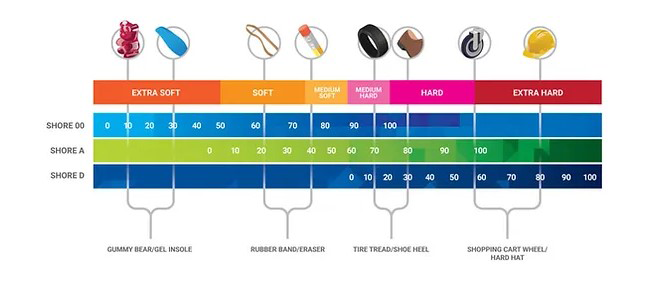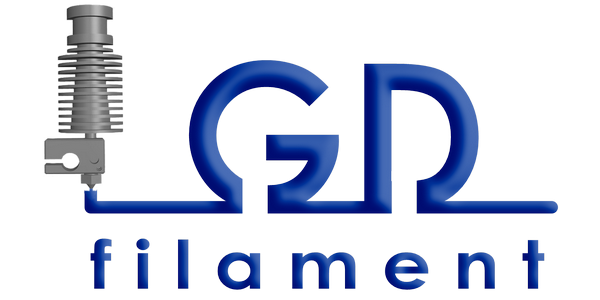Recommended conditions for working with GD Filament filaments
ABS +
Density: 1.04 G / m3 Dielectric constant: min. 15.7 kV; max. 34kV Nozzle temperature: 240 ° С – 260 ° С Bed temperature: 80 ° С – 100 ° С Bed: all types Fan: NO. Odorless – can be operated on open type printers Note: One option (especially for closed type printers – such as Ultimaker) is to use HIPS as a support material, which dissolves in D-Limonene after printing.
ASA
Density: 1.07 G / m3 Dielectric constant: min. 40kV; max. 105kV Nozzle temperature: 220 ° С – 250 ° С Bed temperature: 80 ° С – 100 ° С Bed: all types Fan: NO
FLEX (TPU)
Density: 1.19 G / m3 Dielectric constant: no data Nozzle temperature: 220° С – 250° С. Bed temperature: 60° С – 70° С Bed: all types / PEI is great. Fan: YES (15-20% max or fan OFF). Extruder – direct drive. Print speed: You should experiment with your printer, but 15-20 mm / s is a medium good start. It stick very good to the bed, even its hard to take it out. use a spatule and you could heat additionally the bed to take the TPU ready model out.
FLEX (TPE)
Since 2021 we provide as well another flexible type filaments – TPE, or thermoplastic elastomer. It is a not easy to print filament, because it wraps and after 6-7 layers unsticks from the bed. The recommendations for a successful print are: PRINT SLOWLY! We print with 10-12 mm/s. DO NOT USE RETRACTION, or keep it at minimum possible value. Nozzle temperature: 220° С. For sticking at the bed USE CELLOTAPE, or any type Cellulose tape. The TPE stick very good to it. Bed temperature – 40° С (with Cellotape). Another option is to use any kind of hairspray and print at bed temperature of 70° С. You should experiment with your system to decide which one works best for you.
Note: Types of flexible filaments

PA12
Density: 1.01 G / m3 Dielectric constant: min. 24kV; max. 55kV Nozzle temperature: 240 ° С – 260 ° С Bed temperature: 90 ° С – 100 ° С Bed: epoxy: we recommend FR4/G10 gyrolite. Fan: NO
PC \ ABS
Density: 1.10 G / m3 Dielectric constant: min. 16kV; max. 35kV Nozzle temperature: 250 ° C – 290 ° C Bed temperature: 100 ° С – 110 ° С Bed: all types Fan: NO
PETG
PETG is a material with many advantages, but also with features for printing. Characteristic of it is its great tendency to absorb water, which is why Viagi should be stored in closed (zip-lock) bags with a desiccator bag (moisture absorber, silica gel). It has a tendency to form fibers. In case of high humidity or long-term storage, we recommend drying in a household oven at 65 ° C for 7 hours. Allow to cool in the oven without opening it and immediately place the PETG roll in a desiccant bag. Density: 1.27 G / m3 Dielectric constant: min. 45kV; max. 45kV Nozzle temperature: 240 ° С – 260 ° С Bed temperature: 80 ° С – 90 ° С Bed: all types (recommended PEI) Fan: YES (10-20%) Pay attention to the print speed and travel speed settings.
PLA
Density: 1.24 G / m3 Dielectric constant: no data Nozzle temperature: 180 ° С – 220 ° С Bed temperature: 50 ° С – 60 ° С Bed: all types Fan: YES WOOD Density: 1.28 G / m3 Dielectric constant: no data Nozzle temperature: 180 ° С – 220 ° С Bed temperature: 50 ° С – 60 ° С Bed: all types Fan: YES
PP
Density: 0.895 – 0.92 G / m3. Lowest density filament. Dielectric constant: 2.2 – 2.6 @ 1MHz. Nozzle temperature: 220 ° С – 250 ° С (First layer 220°C, other layers – 240°C). Bed temperature: 60 °С – 70°C. Bed: Smooth PEI with PP tape, PP bed (Prusa), Glass. Fan: YES. Speed 20 mm/s; 25 mm/s perimeters. Flow – 125. Retraction – 0.4 mm, Brim – YES.
WOOD
Density: 1.28 G / m3 Dielectric constant: no data Nozzle temperature: 180 ° С – 220 ° С Bed temperature: 50 ° С – 60 ° С Bed: all types Fan: YES
SILK
Density: no data 1.24 G / m3 Dielectric constant: no data Nozzle temperature: 180 ° С – 220 ° С Bed temperature: 50 ° С – 60 ° С Bed: all types Fan: YES
INTERFERENT
Density: 1.24 G / m3 Dielectric constant: no data Nozzle temperature: 180 ° С – 220 ° С Bed temperature: 50 ° С – 60 ° С Bed: all types Fan: YES
HIPS
Density: 1.02 G / m3 Dielectric constant: no data Nozzle temperature: 230 ° C – 245 ° C Bed temperature: 100 ° С – 115 ° С Bed: all types Fan: NO We recommend working in a closed box.
For PLA max, SILK, WOOD and INTRERFERENT, bed: glass / mirror, we recommend 10-15% aqueous suspension of C200 (polyvinyl acetate adhesive) Apply a thin layer with a brush on the preheated bed and leave for a few minutes to dry. If after cooling your part cannot come off – just wet the glass / mirror with water and leave it for a few minutes. Water will penetrate under the part and dissolve the C200 suspension. This suspension is very durable and can be applied for more than a month with a single application. We also recommend working at a bed temperature higher by 5°C. Working on PEI bed is great. We use sometimes stick glue to make the adhesion better.
For ABS +, PC / ABS, HIPS – bed: glass / mirror, we recommend 10-15% acetone suspension of ABS +. We also recommend applying it in a thin layer with a brush on the preheated bed. It can also be sprayed if you have a sprayer that is convenient for you (be careful because acetone can dissolve some plastic sprayers).
For PA12 we recommend using a special epoxy bed (Garolite) or similar.
HIPS is a product that can be used as a stand-alone model, as well as a support material for ABS, ABS + or PC / ABS. Of course, in this case you need to have a printer with two extruders. Once printing is complete, simply soak the model with the support in D-Limonene, which dissolves the HIPS support and leaves you with a clean model. The amount of d-limonene to use depends on the size of your model. Can be used repeatedly.
Like our page in facebook!
